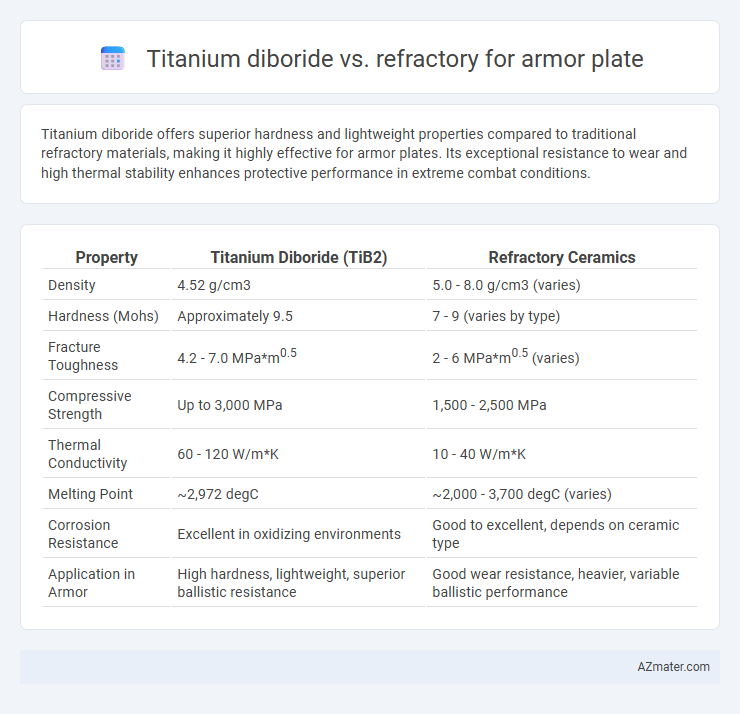Titanium diboride offers superior hardness and lightweight properties compared to traditional refractory materials, making it highly effective for armor plates. Its exceptional resistance to wear and high thermal stability enhances protective performance in extreme combat conditions.
Table of Comparison
| Property | Titanium Diboride (TiB2) | Refractory Ceramics |
|---|---|---|
| Density | 4.52 g/cm3 | 5.0 - 8.0 g/cm3 (varies) |
| Hardness (Mohs) | Approximately 9.5 | 7 - 9 (varies by type) |
| Fracture Toughness | 4.2 - 7.0 MPa*m0.5 | 2 - 6 MPa*m0.5 (varies) |
| Compressive Strength | Up to 3,000 MPa | 1,500 - 2,500 MPa |
| Thermal Conductivity | 60 - 120 W/m*K | 10 - 40 W/m*K |
| Melting Point | ~2,972 degC | ~2,000 - 3,700 degC (varies) |
| Corrosion Resistance | Excellent in oxidizing environments | Good to excellent, depends on ceramic type |
| Application in Armor | High hardness, lightweight, superior ballistic resistance | Good wear resistance, heavier, variable ballistic performance |
Introduction to Armor Plate Materials
Titanium diboride offers exceptional hardness and high melting point, making it an ideal ceramic material for armor plates requiring superior ballistic resistance. Refractory materials, typically composed of metal alloys and ceramics with high thermal stability, provide enhanced durability under extreme heat and mechanical stress in armor applications. Comparing these materials highlights titanium diboride's lightweight yet robust properties against refractories' heat tolerance and structural integrity for advanced defensive solutions.
Overview of Titanium Diboride Properties
Titanium diboride (TiB2) exhibits exceptional hardness, with a Mohs scale rating around 9.5, making it one of the hardest materials for armor plate applications. Its high melting point, approximately 3225degC, combined with excellent thermal conductivity and chemical stability, enhances its performance in extreme environments. Compared to traditional refractory materials, TiB2 offers superior wear resistance and material strength, crucial for advanced protective armor systems.
Key Characteristics of Traditional Refractory Materials
Traditional refractory materials for armor plates, such as tungsten carbide and ceramic composites, offer high melting points exceeding 3000degC and exceptional hardness levels around 1700 HV, ensuring effective protection against projectiles and high-velocity impacts. These materials exhibit excellent compressive strength and thermal stability, maintaining structural integrity in extreme conditions while being relatively dense, with densities typically above 14 g/cm3. However, their brittleness and limited toughness can result in reduced resistance to crack propagation compared to alternatives like titanium diboride, which combines hardness with higher fracture toughness and lower density.
Comparative Hardness: Titanium Diboride vs Refractories
Titanium diboride exhibits superior hardness compared to common refractory materials, with a Mohs hardness of approximately 9.5, making it one of the hardest ceramic materials available for armor plates. Refractory materials like alumina and zirconia typically have hardness values ranging from 6 to 8, which limits their resistance against high-velocity impacts in armor applications. The extreme hardness of titanium diboride enhances its ability to resist penetration and wear, providing improved ballistic protection compared to traditional refractory ceramics.
Ballistic Performance Analysis
Titanium diboride (TiB2) exhibits superior ballistic performance due to its high hardness (around 3,000 HV) and low density (approximately 4.5 g/cm3), making it an ideal candidate for lightweight armor plates. In contrast, traditional refractory materials such as tungsten carbide (density ~15 g/cm3) offer excellent hardness but suffer from greater weight, reducing overall mobility and adding logistical challenges. Ballistic tests demonstrate that TiB2 composites provide enhanced multi-hit resistance and energy absorption efficiency, optimizing protection without compromising maneuverability.
Weight and Density Considerations
Titanium diboride (TiB2) offers a significant advantage over traditional refractory materials in armor plate applications due to its lower density of approximately 4.52 g/cm3, compared to refractory metals like tungsten and tantalum, which exceed 16 g/cm3. This reduced weight enhances mobility and reduces wearer fatigue without compromising ballistic protection. The high hardness and elastic modulus of TiB2 further contribute to efficient energy absorption and resistance to penetration, making it a preferred choice for lightweight, high-performance armor systems.
Cost Efficiency and Material Availability
Titanium diboride offers superior hardness and wear resistance compared to traditional refractory materials, making it highly effective for armor plates, but its high production cost limits widespread adoption. Refractory materials, such as tungsten and molybdenum alloys, provide more cost-efficient solutions with greater availability and established manufacturing infrastructure, enhancing their feasibility for large-scale armor applications. Material availability and processing complexity significantly influence cost efficiency, with refractory options providing a practical balance between performance and economic factors.
Corrosion and Wear Resistance
Titanium diboride exhibits exceptional corrosion resistance due to its strong chemical stability and inert surface, outperforming many conventional refractory materials in harsh environments. Its high hardness and wear resistance make it ideal for armor plates subjected to abrasive and erosive conditions, providing longer service life compared to refractory ceramics like alumina or zirconia. The combination of superior corrosion resistance and superior wear durability positions titanium diboride as a prime candidate for advanced armor applications requiring enhanced protective performance.
Manufacturing and Machinability
Titanium diboride (TiB2) exhibits superior hardness and wear resistance compared to traditional refractory materials, making it an excellent choice for armor plates requiring high ballistic protection. Manufacturing TiB2 armor involves sintering processes such as hot pressing or spark plasma sintering, which enable dense, near-theoretical density components but require precise temperature and pressure control due to TiB2's brittleness. Machining TiB2 is challenging because of its extreme hardness and brittle nature, often necessitating diamond-coated tools and specialized techniques like electrical discharge machining (EDM) or ultrasonic milling to achieve precise dimensions without inducing cracks.
Future Trends in Advanced Armor Materials
Titanium diboride (TiB2) exhibits exceptional hardness and thermal stability, making it a leading candidate over traditional refractory materials such as tungsten and molybdenum in future armor plate applications. Emerging research focuses on nano-structured TiB2 composites that offer enhanced resistance to high-velocity impacts and improved energy absorption under extreme conditions. The trend toward lightweight, multifunctional armor integrates TiB2 with ceramic and polymer matrices to optimize protection while maintaining mobility in next-generation defense systems.

Infographic: Titanium diboride vs Refractory for Armor Plate
 azmater.com
azmater.com